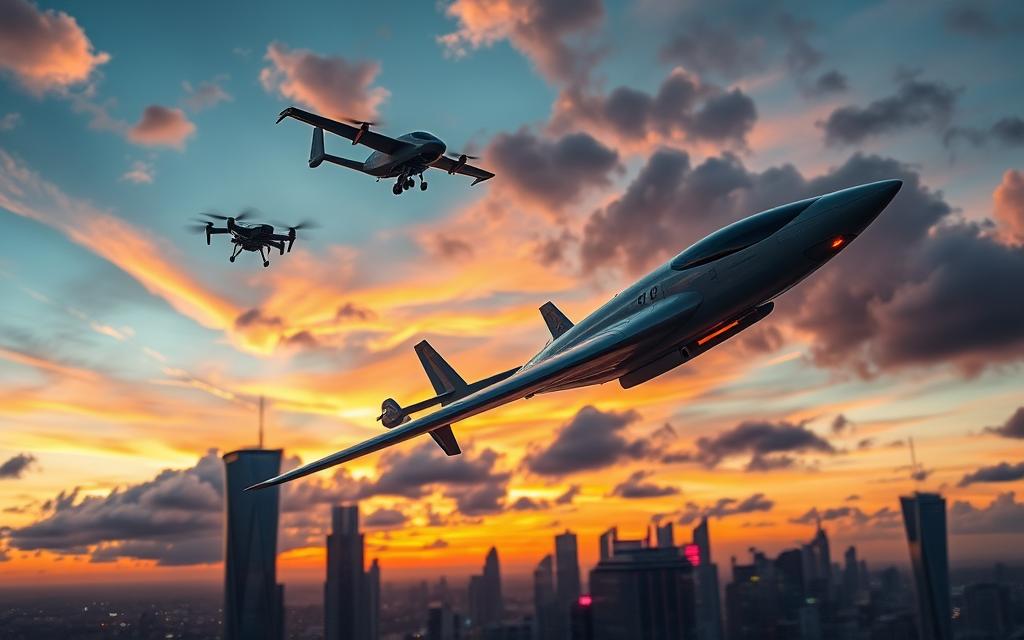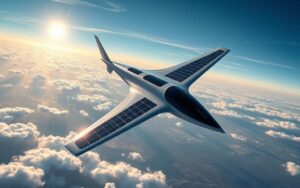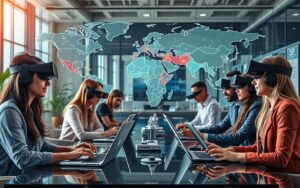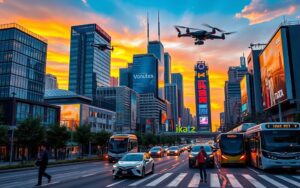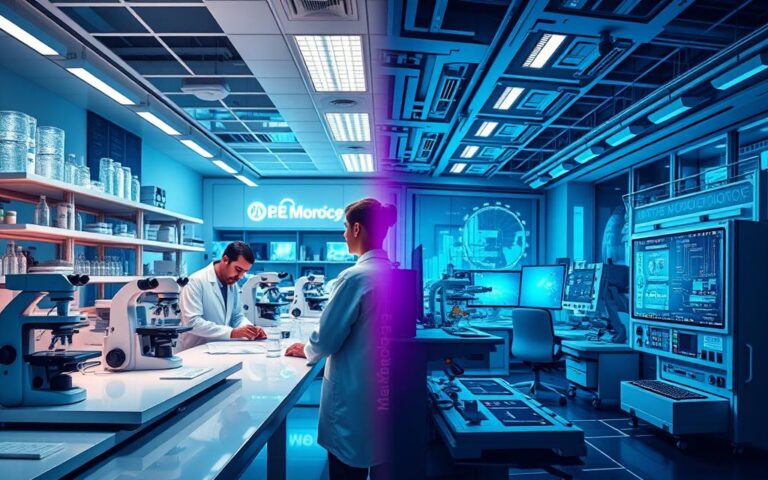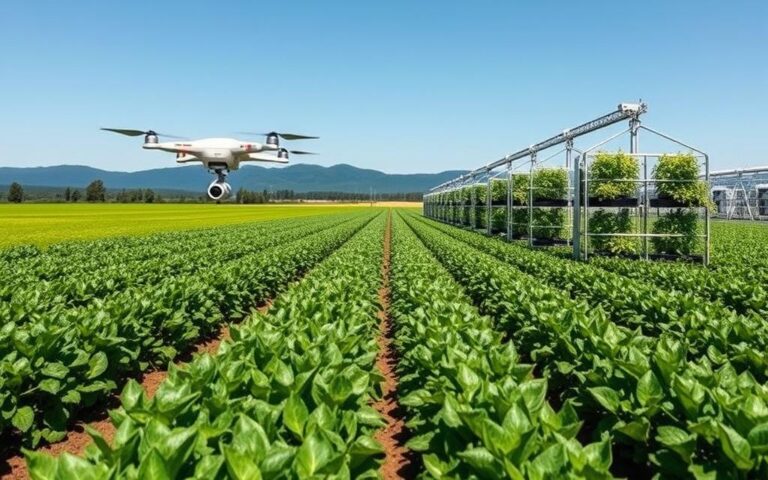Exploring Aviation Technology and Its Advancements
Aviation technology is a fast-growing field. It includes many tools and methods for making, running, and fixing planes. This industry is always changing, making air travel better.
Groups like the NBAA’s Emerging Technologies Committee started in 2019. They focus on bringing new tech into the air travel world. This helps make flying safer and more efficient.
Looking ahead, new ideas like electric planes and drones are exciting. They could help reach places that are hard to get to now. People and companies are working together to make these ideas real.
This teamwork is key to a better future for flying. It’s about making air travel more efficient and green.
Introduction to Aviation Technology
Aviation technology has grown a lot, with big steps in aircraft design, avionics, materials, and safety. This field keeps getting better, making air travel safer and more efficient. An overview of aviation technology shows how far we’ve come from the first flights to today’s high-tech travel.
The history of aviation innovations is full of key moments. These show our drive to fly and our success in making flying better. Today, we have green planes and smart systems. Schools like UC Clermont help by teaching the next generation about this complex field.
Students learn about aviation law, safety, and how people interact with planes. They also use advanced flight simulators. This makes sure they’re ready for the real world of flying.
| Course Title | Credits |
|---|---|
| ATA A102 Introduction to Aviation Technology | 3 |
| ATA A233 Aviation Safety | 3 |
| ATA A331 Human Factors in Aviation | 3 |
| ATA A425 Civil Aviation Security | 3 |
| ATA A490 Advanced Topics in Aviation Technology | 1-6 |
Students dive into the world of aviation, where tech meets learning. They get to fly modern planes at UC Clermont. This hands-on training makes learning exciting. The future of flying is in their hands, thanks to good education and a love for innovation.
Innovations in Aviation Technology
The aviation industry is on the verge of a big change. New technologies are changing how airlines work, making flying better for passengers, and making the industry more green. As we head into 2024, it’s key to know what’s coming in aviation.
Understanding Emerging Technologies in Aviation
Many new technologies are changing the game in aviation. Artificial intelligence is making things more efficient. Autonomous flight systems could change how we fly.
Cloud tech is helping with predictive maintenance. This means airlines can fix problems before they happen, making flying smoother.
Key Trends in Aviation for 2024
Looking ahead, several trends are shaping the future of aviation:
- Sustainability Initiatives: The push for zero carbon emissions is leading to the use of sustainable fuels and more efficient planes.
- Technological Integration: Places like Helsinki Airport are showing the need to update with new tech.
- 3D Printing Expansion: The 3D printing market is set to grow to USD 2.88 billion by 2024, helping in materials science for aerospace.
- AI and Cloud Utilisation: AI and big data will play a bigger role, improving security and making things run smoother.
- AR and VR Advancements: By 2030, AR and VR could be worth USD 77 million, used for training and safety.
These trends for 2024 show a move towards innovation, efficiency, and being kinder to the planet in aviation.
| Year | 3D Printing Market Size (USD billion) | AR/VR Market Size (USD million) |
|---|---|---|
| 2023 | 3.04 | – |
| 2024 | 2.88 | 77 |
| 2028 | 7.37 | – |
| 2029 | 6.74 | – |
What is Aviation Technology?
Aviation technology uses science and engineering to make air travel better. It makes flying safer, more efficient, and greener. The definition of aviation technology includes designing, making, and flying planes, and managing air traffic.
Keeping passengers and cargo safe is a big part of it. Important components of aviation technology are advanced systems, better performance, and regular checks. These help the aviation industry grow.
Places like Lewis University offer courses to get people ready for the industry’s needs. By 2031, over 600,000 new maintenance technicians will be needed. Students learn to work on modern aircraft systems.
Working with companies like United Airlines makes learning better. It brings real-world experience into the classroom.
| Career Opportunities | Specialised Courses | Industry Partnerships |
|---|---|---|
| Maintenance Technicians for Commercial Aviation | Aviation Practices I and II | United Airlines |
| A&P Mechanic | Aviation Fundamentals I and II | Various Aviation-Related Companies |
| Helicopter Technician | Aircraft Turbine Engines | Directors of Maintenance |
These training programs make sure the industry has the right people. See what Purdue offers to learn more about aviation’s future.
Artificial Intelligence in Aviation
Artificial Intelligence is changing aviation a lot. It’s making flight operations better and more efficient. Airlines are using AI to improve how they plan routes, schedules, and safety checks. This is important because air travel is expected to double in the next 20 years.
AI Applications in Flight Operations
AI is key in making aviation modern. Swiss International Air Lines saved a lot of money and improved efficiency with AI. Delta Air Lines also saw a big improvement in predicting wind patterns, cutting down on delays and cancellations.
These changes help save fuel and reduce harmful emissions. They help the industry be more efficient and environmentally friendly.
Machine Learning for Predictive Maintenance
Predictive maintenance uses machine learning to spot potential problems before they happen. AI looks at data from sensors to find trends. This lets maintenance teams act early, saving money and keeping flights running smoothly.
As safety and cybersecurity are top priorities, machine learning is crucial. It helps keep aviation systems safe and ensures AI-assisted operations work well.
Advancements in Autonomous Aircraft
The world of flying is changing fast with new tech in autonomous aircraft. This change is thanks to lots of research and new technologies. It’s making flying safer and more efficient.
Potential of Autonomous Flight Technologies
Autonomous flight tech could change flying a lot. In the U.S., 68-71% of small plane crashes could be stopped with safety systems. Companies like Reliable Robotics are working on better navigation systems.
This tech aims to cut down on accidents like flying into the ground or losing control. It’s a big step towards safer skies.
Current Autonomous Aircraft Developments
New tech like machine learning and better autopilots is making big strides. Boeing and Airbus have done test flights showing autonomous flying works. They can process data fast and make quick decisions.
This means pilots could work more efficiently. They might fly 50-100% more hours, especially for smaller airlines.
The future of flying looks promising with new tech like electric planes. But, there are still hurdles like rules and public trust. Working together, we can overcome these and make flying safer and more efficient.
The Rise of Electric Vertical Take-Off and Landing (eVTOL)
eVTOL aircraft are changing how we move around cities. They can take off and land vertically, perfect for busy city streets. This technology is key to solving urban traffic problems.
In 2021, investors put $6.9 billion into eVTOL startups. Lilium and Archer Aviation are leading the charge. They plan to introduce seven eVTOL models soon. These planes will make short trips, cutting down on emissions.
There are three main ways eVTOLs are being designed. Improving battery tech is a big focus. A drone even delivered Covid test kits to the Isle of Mull in 2020. This shows how eVTOLs can help in real life.
The eVTOL market is set to hit $30 billion by 2030. The FAA wants to certify them by 2025. They see eVTOLs as a solution for crowded cities, like during the 2028 Olympics in Los Angeles. Keeping traffic flow is key, with EASA’s U-space system helping manage drone flights.
3D Printing in the Aerospace Sector
3D printing has changed the aerospace sector a lot. It brings many benefits for making aerospace spare parts. This new tech lets makers make parts fast and cheaply. It also lets them create parts with complex designs that old methods can’t do.
Advantages of 3D Printing for Spare Parts
Using 3D printing in aerospace brings big advantages:
- Cost Reduction: Companies save a lot of money and time by making jigs, fixtures, and other parts up to 90% faster.
- Weight Efficiency: 3D printing helps make parts lighter. This means planes use less fuel.
- Production Capability: The aerospace sector can make over 70,000 parts a year. This shows 3D printing can grow a lot.
- Environmental Impact: It cuts down on waste and makes complex designs. This helps the environment.
- Rapid Prototyping: 3D printing makes making prototypes quicker. This speeds up new ideas.
Companies like SpaceX and Relativity Space show how good 3D printing is for aerospace. They use it to make things like rocket engines and structural parts. As the industry keeps using this tech, the future of 3D printing in aviation looks bright. It will likely grow more and change how parts are made.
Biometric Technology Transforming Aviation
Biometric technology is changing airport security advancements for the better. It makes travel smoother and faster. Airports like Hamad International Airport use facial recognition and palm vein scanning.
These systems have cut down wait times. Now, passengers can enjoy a quicker journey.
Recent studies show how effective biometric technology is. The TSA tested it at several airports in 2020. The results were promising.
In 2022, more tests were done to improve these systems. Almost all airlines want to use biometric technology at airports.
Investments in aviation have gone up by 14% for 2024. This is because biometrics are becoming more common. By 2028, 60% of airlines plan to use biometrics at key points.
The IATA survey found that 83% of travellers are okay with sharing their data for faster travel. 75% prefer biometrics over traditional ID.
But, there are concerns about data privacy with biometric technology aviation. Laws like the Traveler Privacy Protection Act aim to protect our data. They want to keep travel safe and private.
This new way of travelling is not just about security. It’s also about making travel easier and safer. It’s like the “Know Your Customer” rule in banking, but for travellers. For more on how tech is changing our world, click here.
| Year | Passenger Traffic Growth | Airlines Adopting Biometric Systems |
|---|---|---|
| 2017 | Nearly 4 billion | N/A |
| 2023 | 92% of 2019 levels post-COVID | N/A |
| 2024 | Return to pre-COVID levels | 98% |
| 2040 | Projected to double | N/A |
Using Virtual Reality for Pilot Training
Virtual reality pilot training is changing how pilots learn. It creates a safe space for trainees to practice flying without real risks. This shows how technology is making aviation training better.
The Future of AR and VR in Aviation Training
Studies show virtual reality boosts learning in pilot training. For example, Embry-Riddle Aeronautical University found VR training cuts solo flight time by 30%. The University of Maryland also found VR helps keep knowledge longer.
Lufthansa has trained over 20,000 flight attendants with virtual reality. The U.S. military spends about $14 billion a year on synthetic training. These numbers show virtual training is becoming more common.
In 2022, the European Union Aviation Safety Agency approved a VR simulator for Airbus H125. Airlines and training centres are adding virtual reality to their programs. This makes training more efficient and cheaper.
Augmented reality in aviation is promising for the future. By 2028, the aircraft simulation market could hit USD 8,952.96 million. Even though there are challenges, the benefits of immersive training are clear.
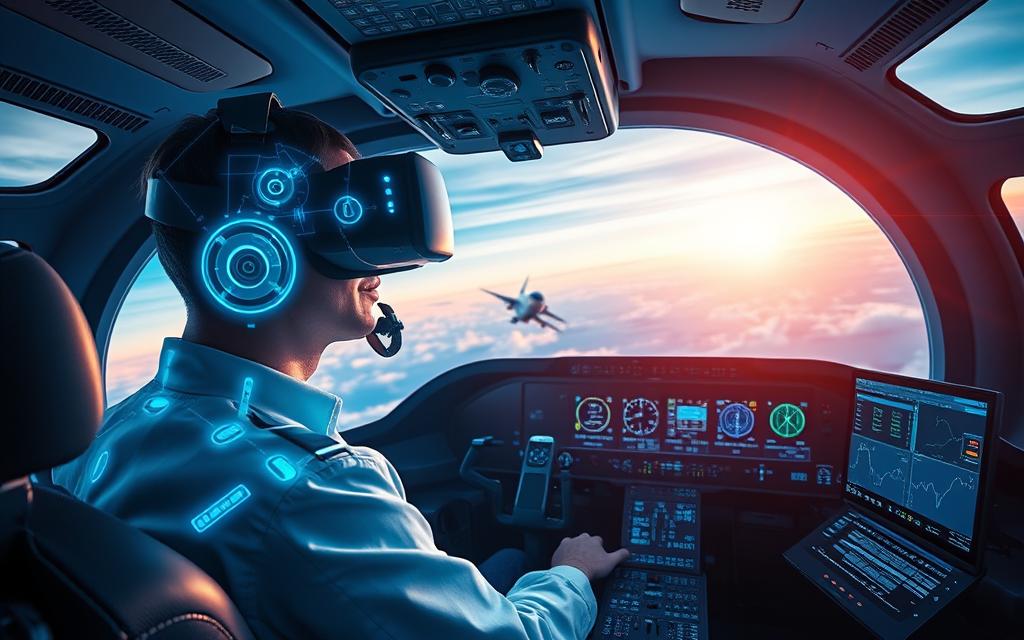
As technology improves, so will pilot training. Virtual and augmented reality will make learning more engaging and effective. The future of aviation training looks bright and efficient.
Impact of Unmanned Aircraft Systems (UAS)
Unmanned Aircraft Systems (UAS) are changing the aviation world, opening up new areas. The market for UAS in transport and logistics is set to grow from USD 11 billion in 2022 to USD 29 billion by 2027. This growth shows how important it is to have good rules for UAS to fly safely with manned planes.
Integrating UAS into National Airspace
Adding UAS to national airspace is a big challenge. Safety and rules need to keep up with these new systems. In 2021, ICAO suggested new rules for UAS, including airworthiness standards.
Clear rules are crucial. Most commercial UAS use will be in farming, helping with work and resources.
Benefits of Unmanned Aircraft in Various Applications
UAS have many uses, making things more efficient and effective. They are key for logistics, aerial surveys, disaster response, and watching the environment. For example, UAS help check on things like power lines and pipelines.
UAS also help in big ways like disaster relief and checking on the weather. With more UAS being made, from 2 million in 2021 to 6.5 million by 2030, their role in industries is growing. UAS do more than just help with moving things; they also help with watching the weather and doing science.
| Year | Market Size (USD Billion) | UAS Production Units (Millions) | Civil UAS Market Size (USD Billion) |
|---|---|---|---|
| 2021 | 11 | 2 | 5.8 |
| 2022 | Projecting | ||
| 2027 | 29 | 6.5 | Projecting |
| 2030 | 18.8 |
In conclusion, UAS are making a big difference in aviation, bringing new ideas and changing how we see airspace. As technology gets better, UAS will help make flying safer and more efficient.
Conclusion
The world of aviation technology is buzzing with new ideas and changes. We’ve seen how artificial intelligence, autonomous systems, and biometric tech are making flying safer and more efficient. These advancements make air travel better for everyone, making it safer and more enjoyable.
There’s also a big push for making flying greener. The use of Sustainable Aviation Fuel (SAF) is a big step towards reducing harm to the environment. The goal is to cut down on carbon emissions by 2050. This shows the industry is serious about changing for the better.
Other trends, like 3D printing and cloud computing, are also exciting. They help make flying more efficient and reliable. These changes are making the future of flying look very promising.
In short, the aviation industry is on the brink of a big change. Thanks to new tech and a focus on being green, flying could become even better. These advancements will not only make flying safer but also inspire future generations of travellers.
FAQ
What are the latest advancements in aviation technology?
Aviation tech has seen big leaps. Artificial Intelligence now helps plan flights better. We also have autonomous planes and electric Vertical Take-Off and Landing (eVTOL) aircraft. These changes will change how we move around cities.
How does Artificial Intelligence improve flight operations?
AI makes flying more efficient. It plans the best routes and schedules. It also checks for safety issues in real-time. This means flying is safer and faster.
What role does machine learning play in aviation maintenance?
Machine learning predicts when planes might need repairs. It uses data from sensors to forecast issues. This cuts down on unexpected maintenance and saves money.
What is the significance of eVTOL technology?
eVTOL tech lets planes take off and land vertically. This makes city travel easier and greener. It helps solve traffic problems.
How is 3D printing transforming the aerospace industry?
3D printing makes making spare parts faster and cheaper. It also leads to better designs and quicker delivery. This is true for everything from cabin parts to engine components.
What advancements are being made in aviation security through biometric technology?
Biometric tech, like palm vein scanning and facial recognition, is making airports safer. It speeds up how we get through security. This means less waiting for everyone.
How are Virtual Reality (VR) and Augmented Reality (AR) used in pilot training?
VR and AR create real-life training for pilots. They practice flying in all sorts of conditions. This makes training more real and effective.
What are Unmanned Aircraft Systems (UAS) being used for in aviation?
UAS, or drones, are used for many things. They do aerial surveys, deliver packages, and monitor farms. They help with logistics and improve surveillance.
What measures are being taken to integrate UAS into national airspace?
Rules are changing to let drones fly safely with planes. This ensures they can operate without risking safety. It’s all about making sure they work well together.
How does the history of aviation innovations shape current advancements?
Aviation’s history shows a never-ending push for better tech. From the first powered flights to today’s advanced systems, we keep getting better. This sets us up for even more progress in the future.
